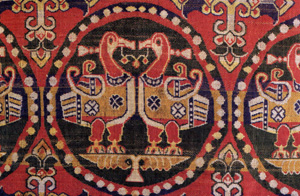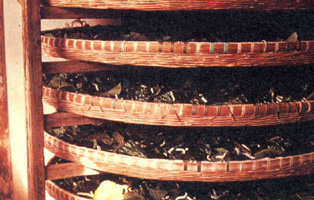- By admin
- In SilkRoadKnowledge
- 2017-12-11
History of Silk

Sogdian silk,8th century
Sericulture or silk production has a long and colorful history unknown to most people. For centuries the West knew very little about silk and the people who made it. Pliny, the Roman historian, wrote in his Natural History in 70 BC "Silk was obtained by removing the down from the leaves with the help of water?". For more than two thousand years the Chinese kept the secret of silk altogether to themselves. It was the most zealously guarded secret in history.
ORIGIN OF SILK - LEGEND OF LADY HSI-LING-SHIH
Chinese legend gives the title Goddess of Silk to Lady Hsi-Ling-Shih, wife of the mythical Yellow Emperor, who was said to have ruled China in about 3000 BC. She is credited with the introduction of silkworm rearing and the invention of the loom. Half a silkworm cocoon unearthed in 1927 from the loess soil astride the Yellow River in Shanxi Province, in northern China, has been dated between 2600 and 2300 BC. Another example is a group of ribbons, threads and woven fragments, dated about 3000 BC, and found at Qianshanyang in Zhejiang province. More recent archeological finds - a small ivory cup carved with a silkworm design and thought to be between 6000 and 7000 years old, and spinning tools, silk thread and fabric fragments from sites along the lower Yangzi River ? reveal the origins of sericulture to be even earlier.
SILKWORM AND THE FAMILY
There are many indigenous varieties of wild silk moths found in a number of different countries. The key to understanding the great mystery and magic of silk, and China's domination of its production and promotion, lies with one species: the blind, flightless moth, Bombyx mori. It lays 500 or more eggs in four to six days and dies soon after. The eggs are like pinpoints ? one hundred of them weigh only one gram. From one ounce of eggs come about 30,000 worms which eat a ton of mulberry leaves and produce twelve pounds of raw silk. The original wild ancestor of this cultivated species is believed to be Bombyx mandarina Moore, a silk moth living on the white mulberry tree and unique to China. The silkworm of this particular moth produces a thread whose filament is smoother, finer and rounder than that of other silk moths. Over thousands of years, during which the Chinese practiced sericulture utilizing all the different types of silk moths known to them, Bombyx mori evolved into the specialized silk producer it is today; a moth which has lost its power to fly, only capable of mating and producing eggs for the next generation of silk producers.
THE SECRET OF SERICULTURE
Producing silk is a lengthy process and demands constant close attention. To produce high quality silk, there are two conditions which need to be fulfilled ? preventing the moth from hatching out and perfecting the diet on which the silkworms should feed. Chinese developed secret ways for both.
* The eggs must be kept at 65 degrees F, increasing gradually to 77 degrees at which point they hatch. After the eggs hatch, the baby worms feed day and night every half hour on fresh, hand-picked and chopped mulberry leaves until they are very fat. Also a fixed temperature has to be maintained throughout. Thousands of feeding worms are kept on trays that are stacked one on top of another. A roomful of munching worms sounds like heavy rain falling on the roof. The newly hatched silkworm multiplies its weight 10,000 times within a month, changing color and shedding its whitish-gray skin several times.

*The silkworms feed until they have stored up enough energy to enter the cocoon stage. While they are growing they have to be protected from loud noises, drafts, strong smells such as those of fish and meat and even the odor of sweat. When it is time to build their cocoons, the worms produce a jelly-like substance in their silk glands, which hardens when it comes into contact with air. Silkworms spend three or four days spinning a cocoon around themselves until they look like puffy, white balls.
Related destinations
Why Choose Us?
We are the top Silk Road tour operator based in Dunhuang, China. We focus on providing well designed Silk Road China Tours with resonable price and thoughtful service.
- Easy & carefree booking
- The best value
- Great travel experience
- Locally operated
Hot Tours
-

6 days Gansu tour to Binglingsi, Xiahe and Langmusi
Tour type : Private tour Price : from *** Destinations : Lanzhou - linxia - Xiahe - Langmusi - Hezuo - Lanzhou -

12 Days Gansu Highlights Tour
Tour type : Private tour Price : from *** Destinations : Xian – Tianshui – Lanzhou – Xiahe – Langmusi – Hezuo – Zhangye – Jiayuguan - Dunhuang -

10 Days Silk Road Classic Tour
Tour type : Private tour Price : from *** Destinations : Xian - Zhangye - Jiayuguan - Dunhuang - Turpan - Urumqi -

5 Days Zhangye - Alxa youqi Highlights Tour
Tour type : Private Tour Price : from *** Destinations : Zhangye - Alax youqi - Zhangye

